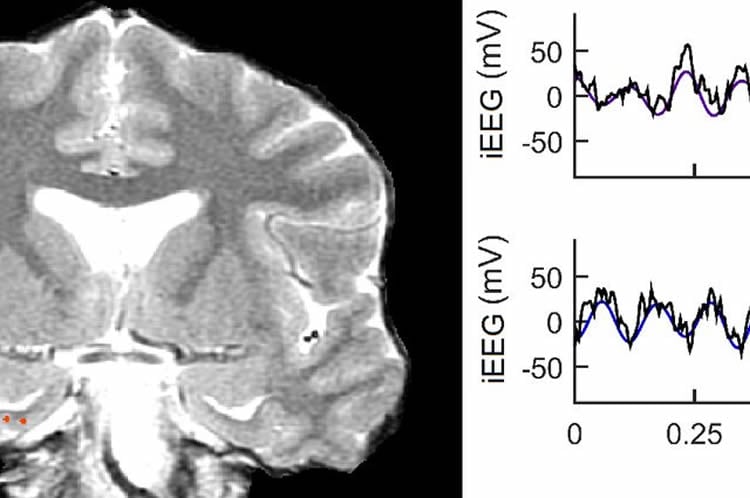Summary: UCLA researchers report theta oscillations occur more frequently when we attempt to navigate an unfamiliar environment.
Source: UCLA.
UCLA neuroscientists are the first to show that rhythmic waves in the brain called theta oscillations happen more often when someone is navigating an unfamiliar environment, and that the more quickly a person moves, the more theta oscillations take place — presumably to process incoming information faster.
In an unexpected finding, theta oscillations were most prominent in a blind person who relied on a cane to move. The scientists hypothesized that a sightless person explores a strange environment through multiple senses, which would require more brain activity to process the extra sensory input.
BACKGROUND
Theta oscillations are one of several types of rhythmic waves in the brain that move, or oscillate, at different frequencies. Theta oscillations, which occur deep inside the brain, are named after the eighth letter in the Greek alphabet because they move up and down eight times per second. Scientists have long suspected that theta oscillations support our ability to learn new places and encode new memories, but no one had previously been able to test the hypothesis in humans.
The region responsible for regulating spatial navigation lies deep inside the brain. The inaccessible location has limited previous studies on the subject to rats or to people who were asked not to move because researchers needed them to be connected to hospital equipment.
METHOD
The study was the first to use a wireless implant to directly record brain waves in real time as people moved freely through an environment.

Researchers analyzed four volunteers who previously had small wireless devices surgically implanted in their brains to prevent seizures. Dressed in motion-capture suits, the volunteers walked at different speeds in a large room as the implants recorded their theta oscillations. The UCLA team tracked the volunteers’ movements and later correlated them to their deep brain waves.
IMPACT
The ability to navigate the world around us is a crucial part of daily life, and the study sheds light on the relationship of theta oscillations to human learning, memory and exploration. In addition, forgetting the route home is also one of the first clues of early Alzheimer’s disease, and the new findings could help inform future studies and the development of new therapies for patients with memory disorders like Alzheimer’s.
Funding: The Defense Advanced Research Projects Agency, the National Institute of Neurological Disorders and Stroke, and the A.P. Giannini Foundation supported the research.
Source: Elaine Schmidt – UCLA
Publisher: Organized by NeuroscienceNews.com.
Image Source: NeuroscienceNews.com image is adapted from the UCLA news release.
Original Research: Full open access research for “Theta Oscillations in the Human Medial Temporal Lobe during Real-World Ambulatory Movement” by Zahra M. Aghajan, Peter Schuette, Tony A. Fields, Michelle E. Tran, Sameed M. Siddiqui, Nicholas R. Hasulak, Thomas K. Tcheng, Dawn Eliashiv, Emily A. Mankin, John Stern, Itzhak Fried, and Nanthia Suthana in Current Biology. Published online November 30 2017 doi:10.1016/j.cub.2017.10.062
[cbtabs][cbtab title=”MLA”]UCLA “Deep Brain Waves Occur More Often During Navigation and Memory Formation.” NeuroscienceNews. NeuroscienceNews, 12 December 2017.
<https://neurosciencenews.com/memory-navigation-brain-waves-8170/>.[/cbtab][cbtab title=”APA”]UCLA (2017, December 12). Deep Brain Waves Occur More Often During Navigation and Memory Formation. NeuroscienceNews. Retrieved December 12, 2017 from https://neurosciencenews.com/memory-navigation-brain-waves-8170/[/cbtab][cbtab title=”Chicago”]UCLA “Deep Brain Waves Occur More Often During Navigation and Memory Formation.” https://neurosciencenews.com/memory-navigation-brain-waves-8170/ (accessed December 12, 2017).[/cbtab][/cbtabs]
Abstract
Theta Oscillations in the Human Medial Temporal Lobe during Real-World Ambulatory Movement
Highlights
•Movement-related 8 Hz theta oscillations occur in the human medial temporal lobe
•Theta occurs in short bouts that are more prevalent during fast versus slow movements
•The duration and prevalence of theta are higher in a congenitally blind participant
•Combined motion capture and iEEG allow for future studies of ambulatory behavior
Summary
The theta rhythm—a slow (6–12 Hz) oscillatory component of the local field potential—plays a critical role in spatial navigation and memory by coordinating the activity of neuronal ensembles within the medial temporal lobe (MTL). Although theta has been extensively studied in freely moving rodents, its presence in humans has been elusive and primarily investigated in stationary subjects. Here we used a unique clinical opportunity to examine theta within the human MTL during untethered, real-world ambulatory movement. We recorded intracranial electroencephalographic activity from participants chronically implanted with the wireless NeuroPace responsive neurostimulator (RNS) and tracked their motion with sub-millimeter precision. Our data revealed that movement-related theta oscillations indeed exist in humans, such that theta power is significantly higher during movement than immobility. Unlike in rodents, however, theta occurs in short bouts, with average durations of ∼400 ms, which are more prevalent during fast versus slow movements. In a rare opportunity to study a congenitally blind participant, we found that both the prevalence and duration of theta bouts were increased relative to the sighted participants. These results provide critical support for conserved neurobiological characteristics of theta oscillations during ambulatory spatial navigation, while highlighting some fundamental differences across species in these oscillations between humans and rodents.
“Theta Oscillations in the Human Medial Temporal Lobe during Real-World Ambulatory Movement” by Zahra M. Aghajan, Peter Schuette, Tony A. Fields, Michelle E. Tran, Sameed M. Siddiqui, Nicholas R. Hasulak, Thomas K. Tcheng, Dawn Eliashiv, Emily A. Mankin, John Stern, Itzhak Fried, and Nanthia Suthana in Current Biology. Published online November 30 2017 doi:10.1016/j.cub.2017.10.062







